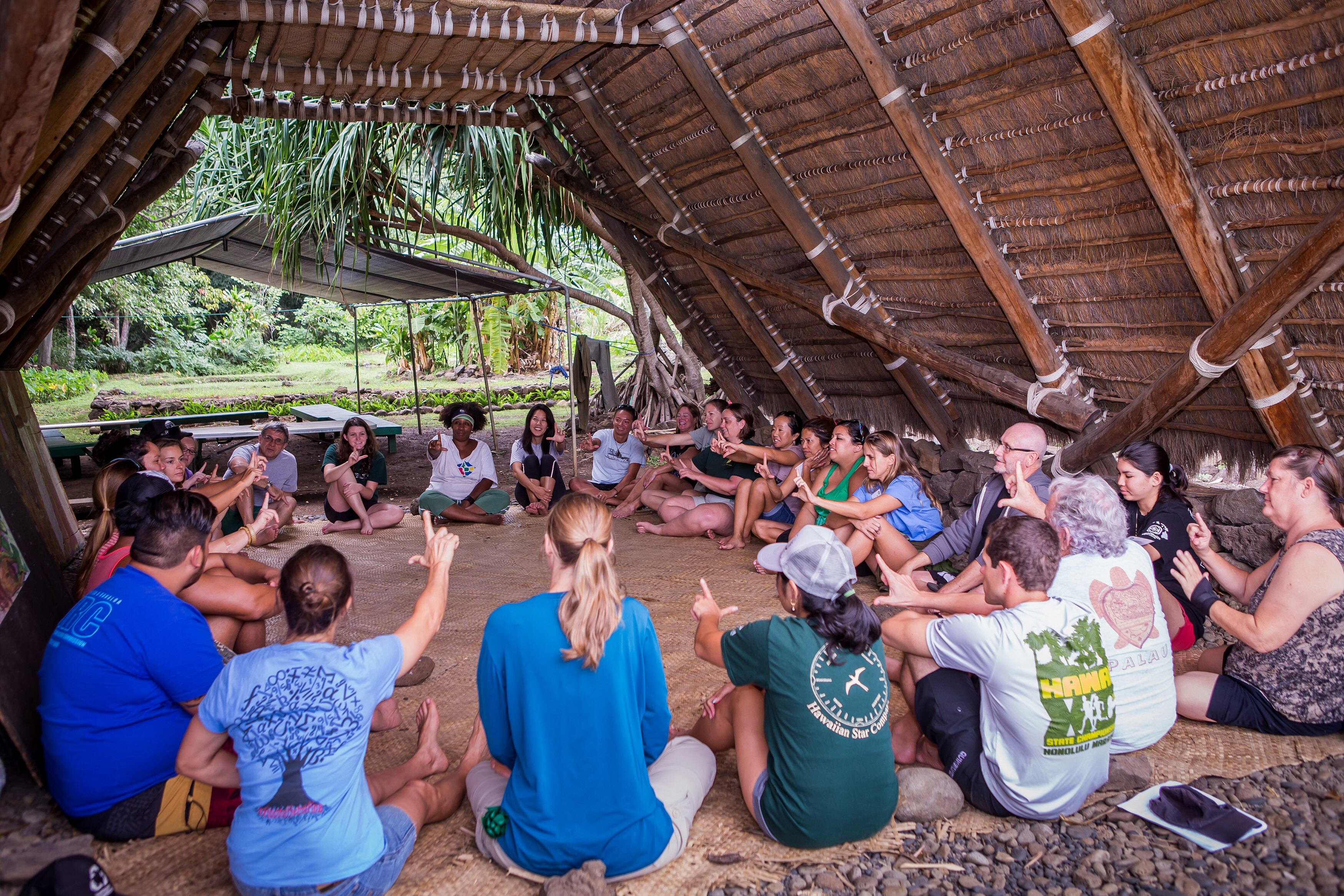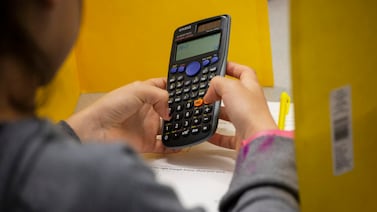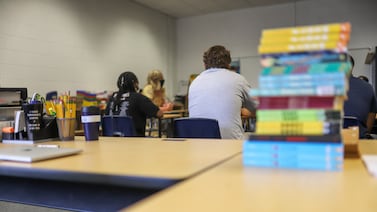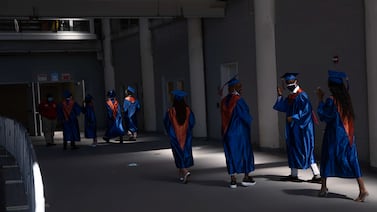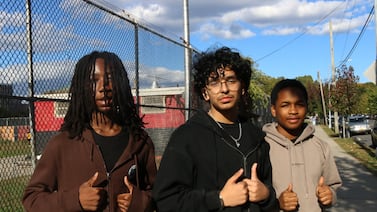This story about ethnomathematics was produced by The Hechinger Report, a nonprofit, independent news organization focused on inequality and innovation in education. Sign up for the Hechinger newsletter.
Before she got to the math in her lesson on linear equations last fall, Sydney Kealanahela asked her class of eighth graders on Oahu why kalo, or taro root, is so important in Hawaii. What do you know about kalo, she asked them. Have you ever picked it?
A boy who had never spoken in class, and never seemed even slightly interested in math, raised his hand.
“He said, ‘I pick kalo with my grandma. She has a farm,’” Kealanahela recalled. “He was excited to tell us about that.”
Class discussion got animated. Everybody knew about poi, the creamy staple Hawaiian food made from mashed taro. Others had even noticed that there were fewer taro farms on Oahu.
That’s when Kealanahela guided the conversation to the whiteboard, plotting data on pounds of taro produced over time on a graph, which created a perfect descending line. The class talked about why there is less taro production, which led to a discussion about the shortage of farm labor.
Kealanahela had taught eighth-grade math for six years at a campus of the Kamehameha Schools, but this was the first time she had started a lesson with a conversation about farming. The idea came from professional development she’d just completed, in ethnomathematics, an approach that connects math to culture by embedding math in a story about something relevant to students’ lives.
Ethnomathematics isn’t new, but until recently it was limited to a niche area of educational and anthropological research on how different cultures use math. Over the past couple of decades, it has evolved into one of several efforts to create more engaging and inclusive math classrooms, particularly for Black, Hispanic, and Indigenous students, who tend to score lower on federal tests than their Asian American and white peers. Ethnomathematics advocates say that persistent achievement gaps are in part a result of overly abstract math instruction that’s disconnected from student experience, and that there’s an urgent need for new approaches that recognize mathematical knowledge as it’s practiced outside of textbooks.
Many Black and brown students don’t feel comfortable in math classes, said Shelly Jones, professor of math education at Central Connecticut State University. She said those classes tend to be “competitive” and that teachers “hone in on what Black and brown students don’t know as opposed to honoring what they do know.” She added: “We are trying to pull in students who have not traditionally felt they belonged in math spaces.”
That said, research on the impact of ethnomathematics is limited, and its practice is largely confined to individual classrooms — like Kealanehela’s — where the teacher has sought out the approach. And teachers who incorporate ethnomathematics without the right support and instructional tools risk stumbling into a cultural minefield, experts say. Most teachers in U.S. classrooms are white. If one of those white teachers decides their Hispanic students should learn base-20 Mayan numbers, and their students ask why, the teacher will have to come up with an answer, said Ron Eglash, a professor in the University of Michigan’s School of Information.
“Telling kids, ‘Because it’s your heritage,’ sounds really awkward from a white teacher,” Eglash said.
But experts say that high-quality ethnomathematics lessons boost student confidence and engagement when used by teachers (of any race) who have been trained and who allow students the time to explore the material on their own and through discussion.
Math isn’t just ‘something the Greeks created’
Ethnomathematics falls under the same umbrella as culturally responsive math instruction. Experts say that teaching math this way requires teachers to get to know their students and create a learning environment where students can connect to math concepts. It involves developing lessons that reveal the math in everyday activities, like skateboarding, braiding, and weaving. It can also include exploring the math involved in cultural practices, like beading.
“A lot of this work is about removing barriers or perceptions from a marginalized population that math is something the Greeks created and is imposed on me,” said Mark Ellis, a professor of education at California State University, Fullerton. He said that culturally responsive instruction takes other measures into account, besides academic outcomes, when determining impact. These include students’ attitude about math, sense of belonging in math classes, and engagement in math discourses.
Traditional math instruction, Ellis said, is treated as if math were acultural, even though, as we know it in the U.S., math descended from the computational traditions of many places, including Mesopotamia (360-degree circles), ancient Greece (geometry and trigonometry), India (decimal notation, the concept of zero) and China (negative numbers). If these mathematical traditions are taught, Ellis and others ask, then why not Hawaiian calculations for slope, sub-Saharan fractal geometry, and Mayan counting systems?
Related: Eliminating advanced math ‘tracks’ often prompts outrage. Some districts buck the trend
Eglash argues that ethnomathematics lessons aren’t just for students from the culture that the lessons draw from. It’s important that students explore math concepts from all cultures, including their own, he said.
Ethnomathematics, a term coined in the 1970s by Brazilian mathematician Ubiratan D’Ambrosio, first appeared in the U.S. about 25 years ago. That’s when Eglash and his wife, University of Michigan design professor Audrey Bennett, developed a suite of teaching modules by which students learn the history or context of a practice — braiding hair into cornrows, for example — and then use algebra, geometry, and trigonometry to create their own cornrow designs with software.
Eglash and Bennett designed the teaching tools with the idea that students can use a module to create their work, which can mean mixing cultures. A Puerto Rican student used Eglash’s module about Native American beading to create a Puerto Rican flag simulation.
In 2009, Richmond City Public Schools asked Eglash and Bennett to teach a module called Cornrow Curves to a class of Black 10th graders. Eglash asked the class where cornrows came from. Their answer: “Brooklyn!” That led to discussion about the African origins of cornrows — where they indicated marriage status, religious affiliation, and other social markers — and on through cornrows’ history during the Middle Passage, Civil Rights, hip-hop, and Afrofuturism.
Only then did the students begin doing math, designing their own cornrows, noticing how the plaits get closer together or further apart depending on the values students enter in a simulation. One student created a design for straight-line cornrows by visually estimating how far to space them apart. In her presentation to class, Eglash recalled, she said that “there are 12 spaces between the braids on one side, which covers 90 degrees, so the braids are positioned every 7.5 degrees because 90/12 = 7.5.”
The Cornrow Curves module and other lessons like it have now been adopted by districts in 25 states. The Los Angeles Unified School District, for example, began offering a culturally responsive computer science curriculum in 2008 that incorporates ethnomathematics lessons that Eglash and Bennett developed. Some evidence indicates that this course helped boost student participation in computer science: An external evaluation found that enrollment in the classes rose by nearly 800 percent from 2009 to 2014.
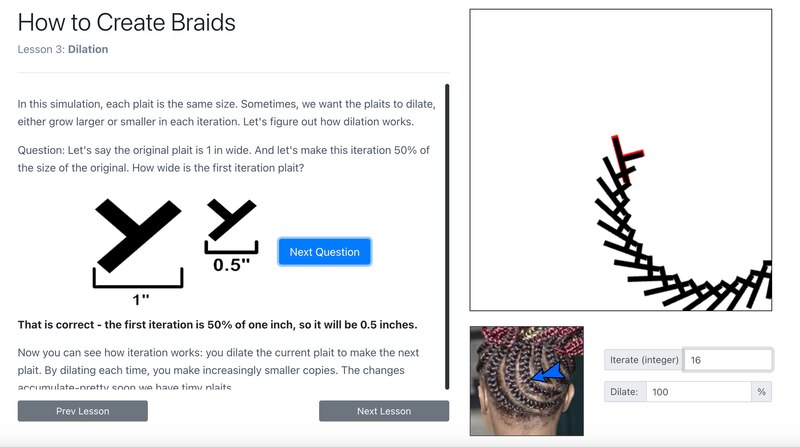
In 2012, Chicago Public Schools adopted the same curriculum for an introduction to computer science course and invested in significant professional development for teachers. In 2016, the intro to computer science course became a graduation requirement for all Chicago high school students, and 250 teachers are trained each year on the curriculum.
An outside analysis of the Chicago program showed that students who took the course before taking AP computer science were 3.5 times more likely to pass the AP computer science exam than those who only took the AP course. A separate study in Chicago and Wisconsin showed that where the course was offered racial and gender achievement divides disappeared and that students were more likely to take another computer science class.
Culturally responsive lessons help students feel like they belong
Keily Hernandez, 15, a first-year student at Chicago’s George Westinghouse College Prep High School, was happy to see the computer science course on her schedule this year, because she plans to major in computer science in college. At first, she found the cornrows module challenging — getting the designs to look the way she wanted them to look was difficult — but it was also fun, she said.
The class is collaborative, she said, and students often turn to each other or to the internet for ideas and help. Hernandez said that taking the class has relieved her doubts that she can be a computer scientist.
“The class made me reassured,” she said. “Math isn’t something that you just know, the same way that computer science isn’t something that you just know. You get better at it the more you do it.”
It’s students like Hernandez that Linda Furuto wanted to attract when she took the job as head of the math and science subdivision at the University of Hawaii West Oahu in 2007. At the time, student enrollment was so low that the school offered just two math courses. Furuto, who had grown up on Oahu and received her doctorate. in math education from the University of California, Los Angeles, recalled thinking, “This isn’t working. We need to implement ethnomathematics here.”
Related: Data science under fire: What math do high schoolers really need?
Over the next six years, she began to integrate ethnomathematics into coursework, and student interest grew. By 2013, the university offered more than 20 math classes.
“Students would say things like, ‘I hated math. I felt no connection to it. But now I see that math is my culture and because of that I want to be a secondary math teacher,’” Furuto said. “Just knowing that the life of a student has in some way, shape or form been transformed speaks volumes.”
In 2018, Furuto established the world’s first ethnomathematics graduate certificate and master’s degree program. So far, about 300 teachers have participated in the online program; about half are from Hawaii.
While teachers in Chicago get ongoing professional development in cohorts both before and while they teach the district’s ethnomathematics-based computer science course, educators who complete the University of Hawaii program are highly likely to be the only teacher at their school with this niche training.
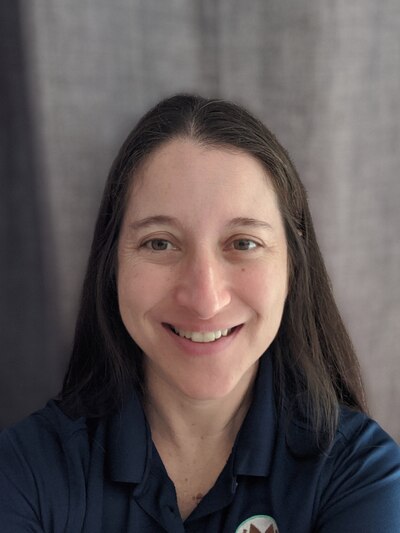
Kealanahela, the teacher on Oahu, said that as inspired as she was by the ethnomathematics program, she doesn’t have time to teach using the method more than twice every three months.
“To create a really good lesson that feels authentic to me, and not just thrown together,” she said, “it takes time to do the research.”
For a teacher who doesn’t have colleagues in their school using the same approach, it can be hard to fit in something new like ethnomathematics, said Janel Marr, a math resource teacher in Oahu’s Windward School District.
Marr was one of the first teachers to participate in the ethnomathematics graduate program, as an eighth-grade math teacher. Today she teaches in the graduate program.“When you go back to the classroom, there are so many other things from all sides, from administration and curriculum to state tests,” she said. “It starts to get overwhelming. It’s not being implemented as much as we in the program would want it to be.”
Math content should relate to the real world
Ideally, said Eglash, ethnomathematics content should be related to real-world situations, even if that involves exploring painful periods of history. Where possible, content should connect with art, history, sports, and math to provide multiple ways for students to interact. This is critical, he said, to address power dynamics and “identity barriers” in the classroom, like the race of the teacher. When teachers let students explore content individually and through group discussion, students gain control over their own learning.
“The teacher finds a way to use the tool that is authentic — which is something the kids pick up on and respect, even for white folks,” he said. “It’s when you are trying to be something you are not that teaching becomes awkward.”
Doing ethnomathematics right can also engage teachers, Marr said. She had been teaching eighth-grade math at Kailua Intermediate School for 13 years when she hit a wall. Her students would ask why they had to learn math, she said, and she didn’t have an answer. She was looking for inspiration when she heard about the University of Hawaii’s ethnomathematics program.
“My students would learn to work with the numbers and everything, but it wasn’t like they were making a connection of why there is slope,” Marr said.
Related: How one district diversified its advanced math classes — without the controversy
After earning her master’s, Marr had the idea to approach linear equations in a new way. She showed her students a photo of a mountain with a long, bare line down its lush, forested side and asked if anyone knew what they were looking at. Most students didn’t.
She wrote a word on the whiteboard: holua. The path, students learned from research they did in class, was made of gravel pounded into lava rocks, and it ran down the side of the Hualālai Volcano on the east side of Hawaii. Elite members of ancient Hawaiian communities sledded down mountainside paths like this one as part of the extreme sport known as holua.
“We talked about those pictures and talked about, well what would the slope be? How fast might they be going? Because slope is really related to the rate of speed,” she said. “Math isn’t just theoretical. It’s having an experience of being part of the place.”

